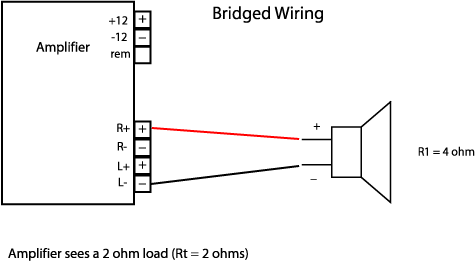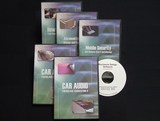Matching Car Audio Speakers and Amplifiers
A question that often comes in by email is, "What amplifier should I buy for my speakers?". Barring specific brand recommendations I'd like to give some general advice on maximizing the bang for your buck when matching car audio speakers, subwoofers and car audio amplifiers.
There are really two subtopics within the main topic. Matching amplifiers to full range speakers is different than matching amplifiers to subwoofers. This is because full range speakers often need to be faded and wired in stereo. Subwoofers do not need these criterion.
Full Range and Component Car Audio Speakers to Amplifiers
This is the most straight forward way of matching car audio amplifiers to speakers. Hook each channel of the amplifier to a single speaker or speaker pair in the case of component speakers. This will give the amplifier a 4 ohm impedance load, the most common speaker impedance in car audio. You can drop the load to most amplifiers by wiring multiple speakers in parallel.
But not all amplifiers will be able to drive speaker impedances below 4 ohms. Most will be able to drive 2 ohm loads, but not all. Some high current amplifiers are capable of driving loads of 1 ohm or less but these are not the norm for non-subwoofer applications. Make sure you know how you will wire your speakers and the impedance the total load will be. Choose an amplifier that is capable of driving that impedance or you may have problems. Also know that decreasing the impedance load on an amplifier will not only increase power (a good thing) but it will also increase distortion, heat and the life of your amplifier (though the difference may be small for quality amplifiers).
In practice you almost never want to connect more than one full range speaker to an amplifier channel. It's true you will get more volume but you will also lose front to rear fading if you run your front and back speakers to a single 2 channel amplifier or your stereo image if you run the left and right speakers off of the same channel. By using a 4 channel amplifier you will retain front to rear fading, a stereo image, your distortion will be less and your amplifier will probably last longer.
Matching Car Audio Subwoofers to Amplifiers
On the other hand, car audio subwoofers do not need to be faded or wired in stereo. This gives us many more options for wiring our amplifier. By planning ahead we can squeeze the most power out of our amplifier usually through a combination of speaker wiring and amplifier bridging.
Bridging an amplifier is a means of combining the power of two channels to drive one speaker. Typically this will double the power of a single channel (i.e. two 50 watt channels would combine to become one 100 watt channel) although some of the top amplifiers will actually quadruple the power of a single channel (i.e. two 50 watt channels would combine to become one 200 watt channel). This is usually the most desirable and you can plan this into your overall design. For example, if you have two subwoofers in your system and you want to drive each of them with 100 watts you can do one of the following.
A. Drive each speaker with its own stereo channel of 100 watts
OR
B. Wire both speakers to a bridged amplifier that produces 50 watts in stereo or 200 watts in mono
Choosing option B will give you the same power but at a lower amplifier cost (lower dollars/watt). You may need to adjust the impedance of the speakers you buy when doing this. If your amplifier is only 2 ohm stable then you will only be able to bridge it to a 4 ohm load. So you must either buy two 8 ohm woofers and wire them in parallel or buy two 2 ohm woofers and wire them in series. Two woofers with dual four ohm voice coils would also accomplish this.
NOTE: When you bridge two channels of an amplifier you will be cutting the "effective" impedance of the speaker load in half. For example, bridging an amplifier to a 4 ohm speaker will make the "effective" impedance 2 ohms. This is why an amplifier can quadruple the power of a single channel when bridged. Each of the previous two channels will see a load of 2 ohms. This would give a stereo output of 100 watts by two channels. Since there is only one channel it combines both 100 watt channels and becomes a 200 watt channel. This is an important point. Many people believe that if their amplifier is 2 ohm stable then they can bridge it to a 2 ohm speaker load. This is not the case as a bridged amplifier will see a 2 ohm speaker load as 1 ohm. Many authors have tried to explain why this is and I have yet to see one do it effectively (for non-engineers). I'm no exception so my advice is just accept it as fact and don't bust your brain on it. Below is a pictorial representation.

Using Dual Voice Coil Woofers to Your Advantage
Many subwoofer manufacturers produce subwoofers that have more than one voice coil and therefore more than one possible impedance load. For example, if a subwoofer has dual four ohm voice coils they could be wired in parallel to give a two ohm load or in series to give an eight ohm load. Likewise a dual two ohm voice coil woofer could be wired for one ohm or four ohms. These re-wired woofers could then be combined with other woofers for even more possible impedances.
As an example, let's say you only want to buy one 12" woofer and your current amplifier is a two ohm stable mono (single) channel amplifier. You could buy either a single voice coil woofer with a two ohm impedance (a rare woofer) or a dual voice coil woofer with a four ohm impedance per coil wired in parallel. Or if your amplifier is a two ohm stable stereo model (two channels) and you wanted to bridge the amplifier to maximize it's power you would want to choose a single voice coil four ohm woofer, a dual voice coil model (eight ohms per coil) wired in parallel or a dual voice coil woofer (two ohms per coil) wired in series. When you understand how amplifier's handle impedance loads and how ohm's law works you'll be one step ahead of most car audio enthusiasts.

The Car Audio Help DVD catalog includes five different videos covering many areas of car audio installation and custom fabrication. Topics range from basic system installation (head units, amplifiers, speakers, etc.) and mobile security (car alarms and remote start) to subwoofer box design and fiberglass fabrication. If you're interested in custom fabrication and car audio installation be sure to check out what we have to offer.
Click here to see the discount DVD packages
Back to the Newsletter Archives Index